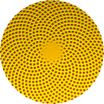(Press-News.org) When people on airplanes ask Alan Newell what he works on, he tells them "flower arrangements."
He could also say "fingerprints" or "sand ripples" or "how plants grow."
"Most patterns you see, including the ones on sand dunes or fish or tigers or leopards or in the laboratory – even the defects in the patterns – have many universal features," said Newell, a Regents' Professor of Mathematics at the University of Arizona.
"All these different systems exhibit strikingly similar features when it comes to the patterns they form," he said. "Patterns arise in systems when they're under some kind of stress, applied stress."
Newell will be talking about the universality of patterns in nature and how those patterns are created, with an emphasis on plants, on Friday, Feb. 18 at the 2011 American Association for the Advancement of Science annual meeting at the Washington Convention Center in Washington, D.C.
Newell's talk, "The Universal Nature of Fibonacci Patterns," is scheduled for 9 a.m. EST and is part of the symposium, "The Growth of Form in Mathematics, Physics and Biology," to be held in Room 147A of the Washington Convention Center. The symposium begins at 8 a.m. EST.
The symposium honors the 150th anniversary of the birth of mathematical biologist D'Arcy Wentworth Thompson.
In 1917, Thompson published an extremely influential book, "On Growth and Form," in which he argued that biological forms are controlled more by the laws of physics than by evolution.
Newell agrees that many of the biological – and non-biological – forms in nature are the products of physical forces, rather than evolutionary ones.
In his talk, he will discuss how the arrangement of flowers, bracts, florets and stickers near the growth shoots of plants – known as phyllotaxis -- is a consequence of biochemically and mechanically induced pattern-forming instabilities.
"All the lovely patterns on plants have their origins in mechanical forces and biochemical processes," he said.
Newell and his students approach the problem of patterns in plants from a mechanistic point of view, he said.
"We look at the phenomenon we're interested in, and we learn about it, we read about it, we find out what other people say about it, and we look at the experimental evidence," he said. "Then we try to capture what we see using mathematical models."
Patterns arise when the symmetry of a system is broken, Newell said. The similarity in patterns from system to system occur when the systems have similar symmetry, rather than because the systems are made from the same materials.
"The mathematics elegantly captures the fact that pattern structure depends more on shared geometrical symmetries than material properties, because the simplified equations for all these very different situations turn out to be the same," he said.
Newell said, "Mathematics is like a good poem, which separates the superfluous from the essentials and fuses the essentials into a kernel of truth."
INFORMATION:
Researcher contact:
Alan Newell
520-626-4885
anewell@math.arizona.edu
Media contact:
Mari N. Jensen
520-626-9635
mnjensen@email.arizona.edu
How nature's patterns form
2011-02-20
ELSE PRESS RELEASES FROM THIS DATE:
Chemist focuses on education for real-world sustainability challenges
2011-02-20
WASHINGTON, D.C. — Introductory college science classes need to improve their coverage of issues related to sustainability, a noted chemistry educator told the American Association for the Advancement of Science today.
"Across the nation, we have a problem," said Catherine Middlecamp, a distinguished faculty associate in chemistry at the University of Wisconsin-Madison. "We are using a 20th-century curriculum, and this is the 21st century."
Students, Middlecamp says, want a curriculum that will prepare them for upcoming challenges related to climate change, pollution ...
Cost-effectiveness research needs to be considered in developing new medical technology
2011-02-20
Cost-effectiveness analysis should play a bigger role in the American health care system, argued a University of Chicago researcher Friday at the annual conference of the American Association for the Advancement of Science.
"The effects of science and technology on health care costs depend on the policy context in which those technologies are developed and applied," said David Meltzer, Associate Professor of Medicine, in his presentation, "Policies to Mobile Technology and Science for Health Care Cost Control."
Meltzer, who also holds a PhD in economics, pointed out ...
Universal flu vaccine study yields success in mice
2011-02-20
Adelaide researchers have taken a step closer to the development of a universal flu vaccine, with results of a recent study showing that a vaccine delivered by a simple nasal spray could provide protection against influenza.
University of Adelaide researcher Dr Darren Miller and colleagues have successfully trialled a synthetic universal flu vaccine in mice. The results have appeared this month in a paper in the Journal of General Virology.
"Current flu vaccines rely on health authorities being able to predict what the forthcoming viral strain is going to be, and reformulating ...
Planetary exploration robots to be featured on science program 'WaveLengths'
2011-02-20
TUCSON, Ariz. (February 18, 2011) -- A University of Arizona College of Engineering researcher and his team who are developing intelligent robots for planetary exploration will be featured in a segment of an upcoming episode of the science program "WaveLengths."
The robots will be featured on the episode premiering Thursday night, February 24 at 8:30 p.m. MST on public television KUAT Channel 6. "WaveLengths" is a quarterly science program hosted by BIO5 Institute Member Dr. Vicki Chandler.
The exploration robots are part of a tier-scalable, reconnaissance system prototype ...
Women are better at forgiving
2011-02-20
A study by the University of the Basque Country (UPV/EHU) has carried out the first Spanish study into the emotional differences between the sexes and generations in terms of forgiveness. According to the study, parents forgive more than children, while women are better at forgiving than men.
"This study has great application for teaching values, because it shows us what reasons people have for forgiving men and women, and the popular conception of forgiveness", Maite Garaigordobil, co-author of the study and a senior professor at the Psychology Faculty of the UPV, tells ...
High-volume hospitals improve orthopedic outcomes
2011-02-20
Patients who undergo elective orthopedic surgeries at high-volume, regional hospitals have better surgical outcomes and experience fewer complications than those who undergo those surgeries at local hospitals, according to research being presented by Hospital for Special Surgery investigators at the 2011 Annual Meeting of the American Academy of Orthopaedic Surgeons (AAOS).
These "regionalizers"—patients who travel to a regional, high-volume hospital—also tend to be younger, white, male and have private insurance, according to the research from Hospital for Special Surgery ...
Knee replacement surgeries take more time, are more costly in overweight individuals
2011-02-20
Knee replacement surgery takes far more time to conduct in overweight and obese patients than in normal weight patients, according to recent research at Hospital for Special Surgery in New York. The study will be presented at the American Academy of Orthopaedic Surgeons annual meeting, held Feb. 15-19 in San Diego, Calif. The study has implications for hospital staff scheduling surgeries, operating room utilization and personnel staffing, and also raises the question of whether knee replacements should be reimbursed based on time.
"When we schedule surgery, the body mass ...
Study shows PRP, commonly used technique to improve healing, doesn't work in rotator cuff surgery
2011-02-20
For years, doctors have used platelet rich plasma (PRP) to promote healing in various surgeries, but a recent study demonstrates that a type of PRP did not improve healing after rotator cuff repair. The study, conducted by Hospital for Special Surgery (HSS) investigators, will be presented at the upcoming American Orthopedic Society for Sports Medicine (AOSSM) 2011 Specialty Day meeting, held Feb. 19 in San Diego, Calif., following the annual meeting of the American Academy of Orthopaedic Surgeons.
"I would not recommend platelet-rich fibrin matrix [PRFM] as we used it ...
Study explores ability of professional dancers to return to their career after hip arthroscopy
2011-02-20
A new study has identified factors that predict the ability of a professional dancer to return to professional performance after hip arthroscopy surgery. The study by Hospital for Special Surgery investigators will be presented at the American Academy of Orthopaedic Surgeons annual meeting, held Feb. 15-19 in San Diego, Calif.
The results of this study indicated that ballet dancers were significantly less likely to be able to return to work compared with modern dancers or dance theater performers. Older age and having a variety of hip abnormalities also influenced outcome. ...
Fountain of youth from the tap
2011-02-20
(Jena, Germany) Professor Dr. Michael Ristow's team along with Japanese colleagues from universities in Oita and Hiroshima have demonstrated by two independent approaches that even a low concentration of lithium leads to an increased life expectancy in humans as well as in a model organism, the roundworm Caenorhabditis elegans. The research team presents its results in the online edition of the scientific publication European Journal of Nutrition which is now online (see hyperlink below).
Lithium is one of many nutritional trace elements and is ingested mainly through ...



